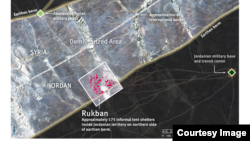Hundreds of refugees fleeing violence in Syria are stranded in the desert just inside the Jordanian border, according to satellite images provided by Human Rights Watch.
Each tiny dot on the map represents one or more people huddling under makeshift tents in the desert heat, the activist organization told VOA.
“It’s a really remote area,” said Bill Frelick, refugee program director at Human Rights Watch. “It looks like a moonscape when you’re out there. There’s nothing. You have to go through conflict zones to get there.”
Frelick told VOA the latest images indicated that refugees desperate to leave the wars in Syria and Iraq faced potentially catastrophic consequences if the international community did not step up and help neighboring countries keep their borders open.
The satellite images show clusters dotted around Rukban and Hadalat in northeastern Jordan, the last informal crossing points that Syrian refugees can use to escape into Jordan. The eastern Syrian border has been closed for some time.
“They are not allowed to go past this berm, a sand wall, that really allows them to get to a safer place," Frelick said. "They are in a particularly dangerous area where they are not getting protection and where they are not getting any humanitarian assistance, either.”
All of Syria’s borders are becoming tougher to cross. What that means, Frelick said, is that it is increasingly difficult for thousands of people in Syria to find refuge from the high levels of violence between warring rebel groups and the Syrian government.
Jordan has received millions of refugees over the years — Palestinians, Iraqis and Syrians — which has put “an enormous burden” on the country, Frelick said. The same strain is being felt by Syria’s other neighbors, Lebanon and Turkey.
The U.N. has registered some 4 million refugees who have fled the Syrian conflict, which erupted in 2011. Some 2.2 million Syrians were in Egypt, Iraq, Jordan and Lebanon, 1.7 million in Turkey and another 24,000 in North Africa. More than a decade of conflict in Iraq, worsened by the presence of the Islamic State extremists, has left an estimated 2.5 million homeless, and about half a million Iraqi refugees.
For Human Rights Watch, neighboring countries are morally and legally obligated to allow people who are directly fleeing threats to their lives and freedom to be able to enter. But Frelick added, “it’s also very much the responsibility of the international community more broadly to provide the support to these countries.”
The conflicts in Syria and Iraq have been described as mega-protracted crises that have no end in sight, putting immense social and economic pressures not only on the region but also on international donors.
The latest U.N. appeal was for $8 billion for an estimated 18 million war-affected people in Syria. But the U.N. appeal last year was only 59 percent funded. So far in 2015, the Jordanian office of UNHCR has received only 17 percent of what it needs.
“We really have a massive problem,” Frelick said. “Part of it is the problems themselves are growing at a faster pace than donor governments are able or willing to keep up.”









